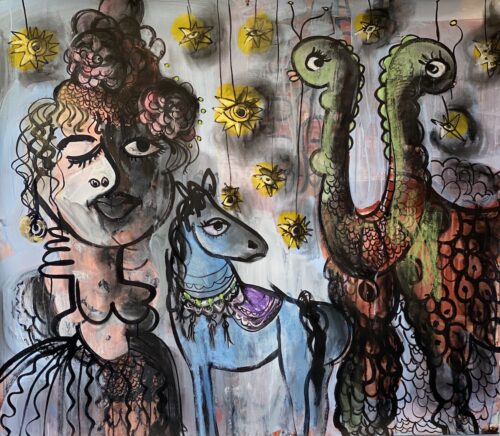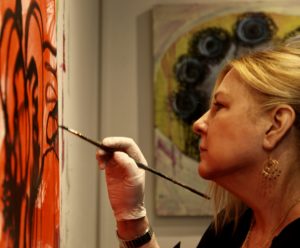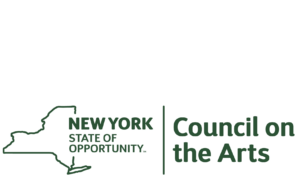In a far-reaching recent interview, artist Deborah Buck recently spoke about her work and process, particularly They Had Stars in Their Eyes featured in The Rains are Changing Fast: New Acquisitions in Context. The interview is part of a larger Museum effort to collect oral histories from living artists in the collection. Buck explores her artistic practice and the themes important to her work. The interview was conducted by Curatorial Assistant Jessica Rosen.
 Jessica Rosen (JR): What is They Had Stars in Their Eyes (2020) about?
Jessica Rosen (JR): What is They Had Stars in Their Eyes (2020) about?
Deborah Buck (DB): I’m so happy that They Had Stars in Their Eyes has a home with the Heckscher Museum. What a wonderful place for my characters to have found themselves. I’m very fascinated by the notion of the carnival. I’m interested in dichotomies, things that look like one thing, but are really another. The carnival presents itself as being light and fun and beautiful, when in fact, obviously, the carnival has a dark underbelly. So for me, these were really fun, wild characters. Overall, it’s about the idea of a hope and a dream, that we all have these notions of our best life. Sometimes it’s a disillusionment and sometimes not.
JR: Could you tell us about your process, specifically, considering how titles lead to the resolution of your work?
DB: Frequently, in the process of making a painting, I destroy it over and over again. Then, I bring pieces of it back. It doesn’t matter if I’m working abstractly, in a narrative fashion, or in a figurative fashion, it’s the same thing. I think the decisions that you make in the course of making a painting are very important. I’m very interested in the process. I want to show the paint for what it can do when I manipulate it, but also, what it can do when I let it go; when I let it drip, when I let it run, when I let it pull up and under, from beneath. I incorporate that, and I celebrate that.
The titles are very, very important to me and to the explanation of my work. I think of the titles as being a guidepost into the painting for the viewer, and it’s a starting point. I really expect the viewer to take the lead from there and ask themselves questions. But in the process of making my work, once I get the title, I’m just bringing it home. It’s like I’ve struggled with it and struggled with and struggled with it. All of a sudden I get the title, I think, “That’s it, that’s it. That’s what I want, that’s what I want.” One of my favorite statements is the Buddhist premise, that the question is the answer. So, I want the titles to be open-ended, and I want the viewer to ask questions of themselves, of the work, of me, of the world.
JR: How do you think They Had Stars in Their Eyes fits into the Heckscher’s collection as a whole  ? What perspective do you feel it adds?
? What perspective do you feel it adds?
DB: I thought a lot about this. The thing that I was really struck by is that a lot of the new acquisitions to the collection are by women. I find that really supportive and exciting. I’m an ardent feminist, and I work very hard for women in the arts. I was really sort of struck by seeing Betty Parsons, who’s one of my heroes, because she was a dealer and a painter. I, at one point, had my own gallery when the art world couldn’t see me, so I kind of went, “Oh, sister, there you are.” Miriam Shapiro, another hero. And obviously, Helen Torr. I feel like I’m a kindred spirit with Helen Torr. I love her work so much. I think she’s a hell of a painter. Then, some of the older works by artists like George Grosz. Those characters in his paintings are symbols and representations of whole countries, whole armies, whole conflicts. I respect his work very much I think that there’s great representation of many faceted artists in your collection, and I’m thrilled to be one of them.
JR: Speaking of your support for women in the arts, could you discuss the Deborah Buck Foundation?
DB: I created the foundation because I had a small investment that I could have just put in the stock market. Instead, I decided I would start this foundation, and it has grown. I support institutions that are actively working to reverse the marginalization of women in the fine arts. Although you can change the world one life at a time, and I understand that, my feeling is that I’m in a hurry. If you don’t change institutions, then we’ll never right the scales when it comes to women and gender equality in the arts.
JR: The Rains are Changing Fast highlights new acquisitions, with pieces from the permanent collection. The resulting visual conversation emphasizes the continuing mission of the museum as a catalyst to discuss ecology, environment, social concerns, identity and abstraction. How does your own artwork featured in The Rains add to the exhibition narrative?
DB: There’s a lightness to this painting. It’s asking questions, but it’s not hitting anyone over the head with identity questions. However, these are very odd characters, and I love them. Why can’t a horse be blue? Why can’t a dragon creature be two-headed? Why can’t this woman have one eye closed, one eye open?
They’re very quirky. I think that’s what we’re all trying to do in this new social environment: accept people who don’t look like us. This is the perfect painting for the Heckscher because these are such odd characters, and yet they’re hopeful. They’re kind of attractive and engaging. They’re, again, about hopes and aspirations that may, or may not, be fulfilled, and that that’s just really part of the timeline of a life. My process and my technique is different from a lot of the classic oil on canvas paintings that are present at the Heckscher. This kind of formalism… Clearly, I’m not a formalist. I can paint very realistically. Then before I know it, I turn it upside down and I’m painting blue horses and double-headed dragons.
JR: How does exaggeration come into play in your work?
DB: My work has always in some way been, not cartoony, but exaggerated. It’s how I’ve drawn and painted since I was quite small. I began drawing when I could hold a pencil. The exaggeration is a part of not wanting to talk about only reality, but talking about a life lived. Sometimes you have to exaggerate, like in a fairy tale, in order to make something seen or understood. This kind of exaggeration is a way of talking about harder ideas and making them palatable. It’s not cute. It is a way of making something, in some way, not scary.
JR: I’m curious to hear more about the characters in this work. Specifically, I am curious about the horse, as you have mentioned before that you’re scared of horses. For example, you depicted a very different horse in Horse Thieves.
DB: That’s true. I grew up on a farm. I spent a lot of time alone on this farm, and there were lots of animals. I read fairy tales, non-stop. I could never get enough books full of fairy tales, Grimms’ Fairy Tales, Andersen’s Fairy Tales like Soup to Nuts, and the idea that animals could speak. I remember sitting by a pond. This frog jumped out and sat on a stone. I thought it was just like the frog in the tale. I hoped it would say, “Hi, Deborah. How are you?'” But, he didn’t.
It was formative for me being alone a lot as a young girl on a farm, and observing the animals and the way the animals treated one another and how they treated me. The horses did scare me, and the cows scared me. All the big animals really terrified me. Then, I was given riding lessons. I was sure that the horse did not want me on its back. I’ve just always kind of thought, “Why does everybody have to jump on a horse and make it do what they want to do? Why not just let the horse do what the horse wants to do?” So, I’ve thought a lot about the power we exert over animals and their own will. There was one little horse, a little pony named Dolly, that actually was nice to me. That was my favorite horse that I would ride at lessons. Similarly, I like this little, blue horse in the painting, and I think that this little, blue horse would not hurt anyone.
JR: Continuing to think about size, how does the depiction of the woman equal in size to the dragon creature contribute to the painting?
DB: She’s very powerful. She’s not really wearing a shirt. She doesn’t care. She’s looking straight at the viewer like, “So what? Big deal. This is me. This is who I am. I’m strong, and deal with it.” And yet, she’s feminine. She has breasts, and a flower in her hair. She’s represented as sort of a sexual creature. I never named her. She doesn’t have a name. None of them have names. And about the dragon, he is not mean or scary. He’s just who he is. He’s actually kind and gentle. They get along. They’re good friends. These three characters are very good friends.
JR: I’d like to talk more about the symbols in this work. Given that this piece has lots of eyes and it’s called They Had Stars in Their Eyes, I’m wondering if you could discuss what the eye as a symbol represents for you?
DB: The eye repeats over and over again in my work. I had always been very interested in Egypt – specifically in the art and the rituals, the characters, the gods. When I went to Egypt, it was as incredibly moving as I thought it would be. I had always been afraid to make eyes all over the place, even though I wanted to. When I got to Egypt, I was like, “Well, if they could do it, I can do it.” So, that’s when the eyes began to be very prominent in my figures and took on a life of their own. I also think that, as an artist, I experience the world visually first. For me, that is intrinsic in why I’m an artist, because I see so clearly. I’m fascinated by looking at things. I’m fascinated by how things look.
The first point of contact, obviously, is my eyes. I’ve worn glasses since I was in kindergarten. I had ophthalmic operations when I was very small. I was always seeing doctors for my eyes. I don’t have great depth perception. So, I think I see things a little differently. The eyes in this piece are your first point of contact. The first thing that you see about the woman on the left is her eye, on the right. The horse is turned so that he’s kind of looking straight at you, but off in the distance, as well. His eye is much bigger than it would be in proportion to a real horse. So, that means that his eye is important. Also, in the dragon creature, the eyes are very soft and alluring, whereas typically a dragon’s eyes are depicted as being sort of slits and flashing. But, this is a different kind of dragon. This is a friendly dragon. So, the eyes are always different. The eyes are very deliberate in all my work. Sometimes I work days trying to get the eye, whereas the rest of it, I may not have labored that hard. But, the eye is always something I have to get perfectly.


